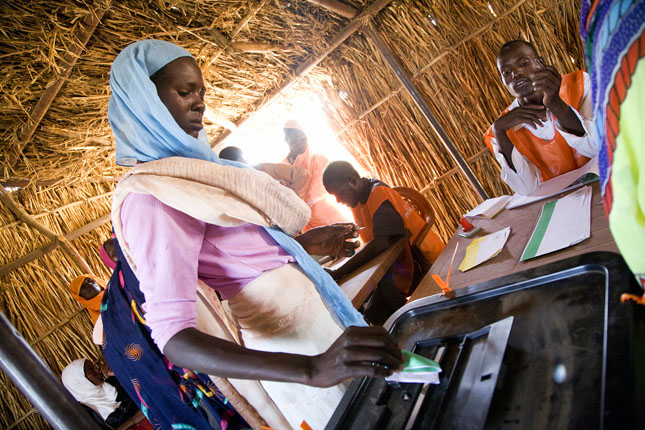-
Can Better Data Lead to More Women in Environmental Leadership Positions?
April 11, 2016 By Maggie Roth
The saying goes, what hasn’t been counted doesn’t count. Our latest datasets for the Environment and Gender Information (EGI) platform are proving this true.
It is well-established that the participation of women in conservation and resource management is an important determiner of sustainability, but when data is not segregated by sex, we see time and time again that women and gender issues remain sidelined.
In the International Union for the Conservation of Nature’s latest update to the EGI, we analyzed reports to the Ramsar and World Heritage Conventions, which govern wetlands and protected areas, respectively. Both conventions are a part of the United Nations and carry requirements to follow gender equality mandates under the human rights framework, including attention to the equal status and human rights of women.
The results were staggering: Of 553 national reports to Ramsar since 1999, a mere 16 percent included references to “gender” or “women.” Even more shocking, of the 1,290 World Heritage State of Conservation reports analyzed, only one percent included these key words.
In collaboration with UN Women, we also built a dataset on women’s participation in environmental decision-making. One of the indicators we looked at was heads of environment sector ministries. Of the 890 leadership positions we analyzed in 193 UN Member States, only 12 percent were held by women.

What hasn’t been counted doesn’t count.
An Advocacy Tool
On March 24, the International Union for Conservation of Nature (IUCN) joined other conservation organizations in New York City during the 60th meeting of the United Nations Commission on the Status of Women to make the case for the importance of sex-disaggregated data and gender-sensitive information specific to the environment sector. Such data can be a powerful tool to advocate for gender equality and women’s empowerment in sustainable development.
When women aren’t equally represented their needs and solutions often go ignoredThe panel focused on combatting inequality with information and included presentations that spanned a variety of efforts – from the World Resources Institute’s Global Forest Watch platform working to include more social data for users, to the Sierra Club’s use of gendered data to advocate for a just and equitable transition to a clean energy future, to Conservation International’s on-the-ground example of sex-disaggregated data collection in the Philippines.
IUCN was proud to present some of the latest datasets for EGI, an umbrella knowledge platform which includes the pilot Environment and Gender Index – a composite index ranking 73 countries across 27 gender and environmental dimensions. The datasets and analysis included in the EGI platform aim to measure progress, identify gaps, improve information, and – maybe most importantly – empower countries to take steps forward for gender equality and the environment.
Over the past three years since the EGI’s pilot phase, we’ve not only created the index, we’ve also begun to build and expand datasets focused on women’s participation in specific environmental sectors. The data from UN Women highlights enormous gaps in instrumental decision-making positions – key spaces where women’s voices need to be heard.
Environment ministries are the ones that develop policies and programs to manage natural resources, perform critical roles in environmental governance, oversee project implementation, and develop capacity for environmental conservation. When women aren’t equally represented in these positions, their needs, perspectives, and solutions often go ignored.
More Goals, More Data?
Collating the best quantitative data available on how countries are realizing their commitments to environmental sustainability and women’s empowerment, our EGI consistently finds that countries that take seriously their commitments to advancing gender equality in environmental arenas are making strides toward long-term wellbeing for all their citizens.
We view this not only as an influential advocacy angle, but an important opportunity to hold governments accountable for the Sustainable Development Goals (SDGs). The SDGs are seen as an exciting step towards defining an ambitious interdisciplinary approach to tackling global development and environment goals. However, the goals and targets adopted by United Nations member states last year are only the beginning.
There are few indicators to track participation in environmental decision-makingData on the inclusion of gender and the promotion of women’s participation in national and international level policies and programs in various sectors is critical for advocacy, and also importantly, for accountability.
SDG 5 aims to end all forms of discrimination against women and girls everywhere and eliminate all forms of violence against all women and girls in the public and private spheres, including trafficking and sexual and other types of exploitation.
SDG 13 urges for action to combat climate change and its impacts. The EGI builds data and knowledge that marries the two goals and sheds light on these often unrecognized and under researched themes.
We see time and time again via case studies and anecdotes that inclusive and equitable participation in the design, implementation, and decision-making of environmental management is critical to the sustainability of natural resources. Yet there are few indicators to track participation in environmental decision-making and fewer still that look at the inclusiveness and equity of those decisions, particularly for women.
We think the EGI can begin to shed light on some of these under-researched and not fully understood areas – making sure women and gender equality issues count.
For more information about the EGI and the work of IUCN’s Global Gender Office, please visit our website and follow us on Twitter.
Maggie Roth is the communications officer for the International Union for Conservation of Nature’s Global Gender Office, where she works to engage the public in conversations about climate science, its inherent problems, and potential solutions – striving to make it more broadly accessible and understood through effective communication and increased public involvement in policy discussions.
Sources: International Union for the Conservation of Nature, UN Women.
Photo Credit: Voting in North Darfur, April 2010, courtesy of Albert Gonzalez Farran/UN Photo.
 A Publication of the Stimson Center.
A Publication of the Stimson Center.




